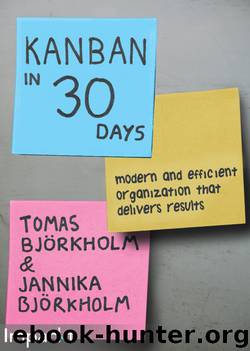Kanban in 30 Days by Unknown

Author:Unknown
Language: eng
Format: epub
Publisher: Packt Publishing
The interesting result is shown in the following table:
Changing limit
Difference in throughput
Difference in time to market
100 to 5
-31%
-70%
100 to 8
-19%
-59%
100 to 13
-12%
-48%
100 to 20
-5%
-34%
This means that if you set the limit to 20, you lose only 5 percent on throughput, but you will be done in much less time. If time to market is really important for you, you can set the limit to 5 and be done much quicker.
What limit should you start with?
It's now time to decide which limit to begin with. Without running for a time, it's very hard to predict what would be the best balance between throughput and lead-time. Your first decision is about how important quick time to market is for you. If it is very important, we suggest you start with tough (low) limits. In practice, that means that the normal is that people are waiting for work instead of work waiting for people to take care of it. In other words, you want the next work station/process step to be ready to start working when you are ready with your part of the work.
If time to market is not very important, you can start with wider limits and allow some buffers to build up between process steps just to make sure everybody almost always has something to do.
The reasons for having queues between process steps is to have a buffer to handle variation caused either by different work capacity, like in the match game previously, or different amounts of work.
A good flow is created by slack, that is, the time when some people actually have nothing to do. This time could be used to improve their own way of working or helping others who at the moment have more to do.
Limits do not need to be digital, either it's one or it's zero, in the way that as long as you are under the limit, it's fine to add more work until we reach the limit and then absolutely nothing more. Instead, we suggest you have the last available queue places saved for extreme cases. This gives pressure to have the smallest possible limits but be able to handle cases of extreme variation. In the following example, there is a hard limit of 4 but a soft limit of 3:
A Kanban board with a hard limit of 4 and a soft limit of 3
Download
This site does not store any files on its server. We only index and link to content provided by other sites. Please contact the content providers to delete copyright contents if any and email us, we'll remove relevant links or contents immediately.
Weapons of Math Destruction by Cathy O'Neil(5831)
Cracking the GRE Premium Edition with 6 Practice Tests, 2015 (Graduate School Test Preparation) by Princeton Review(4046)
What It Really Takes to Get Into Ivy League and Other Highly Selective Colleges by Hughes Chuck(3553)
Fooled by Randomness: The Hidden Role of Chance in Life and in the Markets by Nassim Nicholas Taleb(2861)
The Tyranny of Metrics by Jerry Z. Muller(2849)
The Marketing Plan Handbook: Develop Big-Picture Marketing Plans for Pennies on the Dollar by Robert W. Bly(2796)
Ultralearning by Scott Young(2731)
The Official Guide for GMAT Review 2015 with Online Question Bank and Exclusive Video by Graduate Management Admission Council (GMAC)(2644)
50 Economics Classics by Tom Butler-Bowdon(2410)
The Visual MBA by Jason Barron(1979)
The Inevitable by Kevin Kelly(1835)
Data Science for Business by Foster Provost & Tom Fawcett(1814)
Out of the Crisis by Deming W. Edwards(1760)
GMAT Official Guide 2018 Verbal Review by GMAC (Graduate Management Admission Council)(1704)
Cracking the LSAT, 2012 Edition by Princeton Review(1690)
The Personal MBA: Master the Art of Business by Josh Kaufman(1649)
The Conflict Resolution Phrase Book by Barbara Mitchell & Cornelia Gamlem(1648)
Maths and Stats for Web Analytics and Conversion Optimization by Himanshu Sharma(1565)
College Essays that Made a Difference by Princeton Review(1551)
